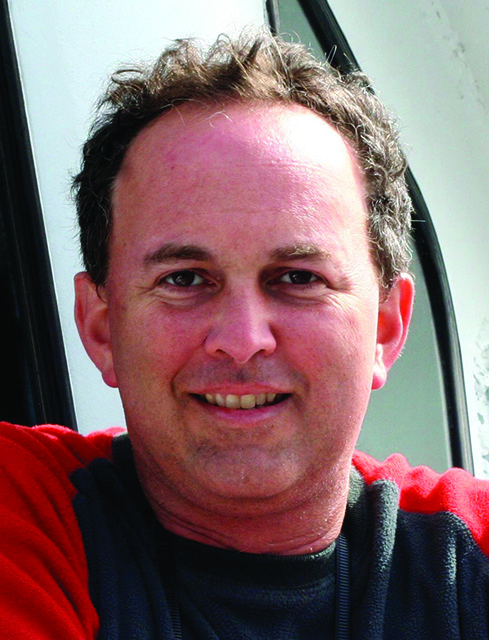The Go-To Guy
In ancient times, it was a dangerous business being avant-garde, at the front of an army or fleet heading into battle. These days, being at the vanguard is still risky, but George Bodenheimer believes taking those chances are essential for keeping a business thriving and growing.
Bodenheimer is characteristically modest when he says, “We're very proud of what we built,” but then emphasizes, “It's not about me. It's about ESPN and all 4,000 people that work here.”
But the boss, who has been with the company since 1981, gets the credit, because he creates an environment that encourages creative thinking. “He pushes and challenges and wants a constant state of evolution,” says Chuck Pagano, senior VP of technology, engineering and operations.
Perhaps Bodenheimer's enthusiasm is an indicator of how much he wanted to be in the sports world. He unsuccessfully tried to land a job with every single Major League Baseball team and was rejected by Madison Square Garden, too.
Bodenheimer's attitude helps create a place where people push the envelopes of creativity. “He invests the organization with this kind of culture,” Pagano says. “He wants it to be an incubator of innovation, and there's no caste system here. All ideas are welcome from everyone.”
Bodenheimer went from the mailroom to affiliate sales in the Southern U.S. But by the end of the 1980s, he was back at ESPN's headquarters in Bristol, Conn., in the role of VP of affiliate sales and marketing.
That made him part of the programming team, too, and after then-President Steve Bornstein left in 1998, Bodenheimer became ESPN's president. In 2003, he also became president of ABC Sports. And a year later, he was named the Most Powerful Person in Sports by The Sporting News.
Broadcasting & Cable Newsletter
The smarter way to stay on top of broadcasting and cable industry. Sign up below
By all accounts, Bodenheimer is still a boss who mixes it up with the whole staff—but he also tells it like it is. “He's honest and tells you what he's thinking, even if it's not always what you want to hear,” says Sean Bratches, president of Disney and ESPN Network affiliate sales and marketing.
ESPN touts itself to the public as “the worldwide leader in sports,” the home to all sports and the first network to introduce the digitally created 1st-and-10 line for football, as well as the baseball strike zone outline for viewers. It has also made ratings splashes with innovative series and movies like Playmakers, Tilt, The Junction Boys and 3.
Bodenheimer made ESPN the first network to ink deals with four major sports, but he needed to take risks to generate ratings that didn't involve rights fees—such as movies or quirky shows like Pardon the Interruption and Dream Job, a reality show in which contestants vie to become real, employed-and-paid anchors on ESPN's dominant SportsCenter; as a program, SportsCenter was inducted into B&C's Hall of Fame last year (as was Bodenheimer).
SportsCenter, of course, almost gives ESPN its own language, and long-time viewers enjoy the goofy moments at ESPN just about as much as they do the coverage. Under Bornstein and then Bodenheimer, ESPN learned not to take itself too seriously.
But what really keeps ESPN out front are its innovative and creative moves that are less directly connected to balls and strikes, interceptions and touchdowns, dunks and blocks. ESPN isn't even simply one network anymore. It is a growing potpourri of networks, including the recently added ESPN Deportes (Spanish-language ESPN) and ESPNU (all college sports all the time).
And Bodenheimer says there is more to come. “I don't see [the addition of networks] stopping.”
ESPN is more than just cable television now. It is omnipresent, thanks to an award-winning magazine, a heavily trafficked Web site, a restaurant chain and a line of videogames.
The network also stays ahead of the game in technology, with additions like ESPN Motion (enhanced Web-site video technology) and ESPN HD, which has proved to be a driver in the HDTV business. Most important, it had a new high-tech production center built last year at the headquarters in Bristol.
“The digital center is the new heart of ESPN,” says Bodenheimer. “It is able to fuel all of our new businesses.”
Bodenheimer constantly seeks opportunities to “exploit technology to serve the ESPN brand and to serve sports fans,” and with ESPN 360, he is now focusing on wireless technology, with a cellphone business to launch within the year.
“George is a closet geek, and he just shows it through his support of our technology efforts,” Pagano says. He explains that Bodenheimer is somewhere between a hands-on boss and one who knows when to leave people alone. In other words, he knows the details and knows when to get out of the way.
The one thing Bodenheimer never allows, Pagano says, is complacency: “He knows yesterday is gone and none of us will ever hit the finish line, but it's the journey that counts.”
Stuart Miller has been writing about television for 30 years since he first joined Variety as a staff writer. He has written about television for The New York Times, The Washington Post, the Los Angeles Times, The Guardian, The Boston Globe, Newsweek, Vulture and numerous other publications.

